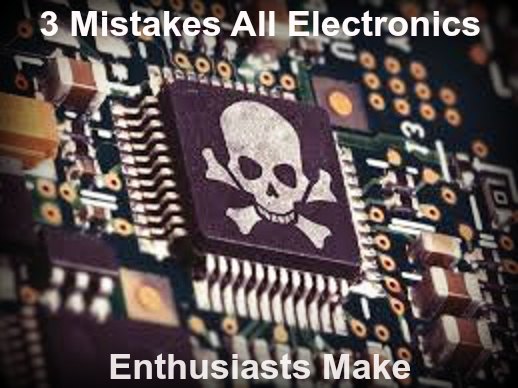
Electronics hobbyists and enthusiasts are a very dedicated bunch. I should know, not only am I an enthusiast, I’m an EE.
In many of my posts, I talk about various topics on electronics and occasionally computers (they are electronic, after all). This time I wanted to do something a bit different and talk about the hobby itself rather than discuss some type of component, protocol, or electrical theory. In that vein, this post will be a bit shorter than some of the others, but no less important if you’re an electronics hobbyist or enthusiast.
Below are three common mistakes I’ve seen many electronics hobbyists make. I’ve also made some of them myself. To help you avoid these mistakes, I list them and then go into some detail about each one.
Be sure to read all three (short) mistakes. At the end, I have a special bonus for those who are interested.
The 3 Common Mistakes All Electronics Hobbyists & Enthusiasts Make
- Only working with trainers (like Arduino) and no naked microcontrollers (like the PIC)
This is something that has only become a real issue in the past decade or so, but it’s also something I’m seeing more electronics hobbyists do. In fact, it’s so common that I even wrote a complete blog post on this.
Things like the Arduino and RPi have helped many school-aged children and non-engineers alike spark an interest in electronics and programming. They excel for applications like learning and prototyping projects, but if you only work with trainers, you’re missing a lot.
Yes, working directly with a stand-alone microcontroller will be harder at first, but stick with it — it’s worth it. Start with one you may be familiar with: the ATmega328P, the brains behind the Arduino Uno. Then try another micro, like the PIC.
If you want more detail and some good reasons why you should learn to work with the stand-alone microcontroller check out the blog post I mentioned above.
- Focusing mostly on projects and not learning enough theory
It’s easy to copy someone else’s design and build a working gadget. However, if you want to be able to design your own widgets and understand how the stuff you’ve built works you’ll need to understand some electrical theory.
Things like circuit analysis techniques and other theoretical stuff can come in handy when troubleshooting an electronic device or repairing it.
Become the Maker you were born to be. Try Arduino Academy for FREE!

And yes, learning some math won’t hurt either. You should at least be decent at algebra and trig; knowing something about calculus isn’t a bad idea.
You likely know about Ohm’s Law already. Take the time to learn about different circuit analysis techniques and more about the components, too. There are a ton of books, magazines, and online resources (like this blog) that can help you with this.
- Focusing mostly on theory and not getting your hands dirty
This one is sort of the converse of #2. It’s also one that I’ve been guilty of myself in the past. Sometimes, things look good on paper and simulations go well, but when built you find it doesn’t work as expected.
While in college earning my electrical engineering degree, many classes had labs associated with them in addition to the class itself. I remember dreading days when we had lab because labs usually lasted three and a half hours. After that came the lab report.
There’s a good reason colleges do this, and looking back I actually miss the labs. To be proficient in electronics you need a mixture of theory and hands-on learning.
They say experience is the best teacher. I’m not sure if that’s always true, but a healthy balance between theory and practice won’t steer you wrong.
And now a bonus for all the electronics hobbyists & enthusiasts 
Believe it or not, there are many more common mistakes that electronics hobbyists make all the time. This post has limited room to explain them all, but in my electronics endeavors I’ve seen people make 7 other key mistakes. And again, I’ve made some of those mistakes myself.
In fact, the mistakes I’ve already talked about and the 7 other mistakes I’m referring to are so common that I created a checklist that covers all 10 of the mistakes and what to do to avoid them. I created it because I don’t want to see other people make the mistakes.
And as an exclusive bonus, I’m offering the checklist that covers all 10 mistakes to my newsletter subscribers.
That’s right, the complete list is exclusive and won’t be published on this blog, but for a limited time I’m making it available to my subscribers as a special gift to say “thank you.”
If you want to know what the other 7 mistakes are, just enter your name and email in the form below and it will be instantly sent to your inbox.
And we hate spam, so rest assured we’ll never spam you or share your email with anyone. In fact, a post about computers and how to avoid spam may appear on this blog in the near future. And I promise not to hit you over the head with tons of emails and promotions.
You’ll receive the complete checklist and my newsletter (usually 2x per month) packed with tons of electronics tips, tricks, and even some exclusive content just for you.
Simply enter your information below to instantly download the complete checklist 10 Common Mistakes All Electronics Enthusiasts Make…And How to Avoid Them.
Become the Maker you were born to be. Try Arduino Academy for FREE!

Electronics Tips & Tutorials Sent Directly to Your Inbox

Submit your email & you'll get:
- Exclusive content that I don't put on the blog
- The checklist 10 mistakes all electronics enthusiasts make (& how to avoid them)
- And more!
thanks bro